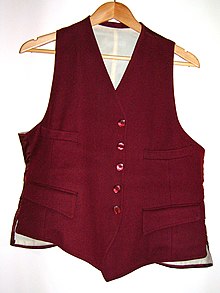Vest
A vest is a garment covering the upper body. The term has different meanings around the world:
- Waistcoat
- (a sleeveless under-jacket). This is called a waistcoat in the UK and many Commonwealth countries, or a vest in the US and Canada. It is often worn as part of formal attire, or as the third piece of a lounge suit.
- Undershirt
- (an undergarment, normally worn under a shirt). It is known as an undershirt in the US and Canada, vest in the UK and many Commonwealth countries, and singlet in Australia and Asia, and is typically in the form of a T-shirt or sleeveless/longsleeve (ribbed)top. It is also known by the slang name wife-beater or just beater for short in various countries.
- Other sleeveless jackets
- Vest may refer to other outer garments, such as a sports tank top, or a padded sleeveless jacket popular for hunting, commonly known as a hunting vest. Another common variant is the fishing vest which carries a profusion of external pockets for carrying fishing tackle. The term jerkin is also used to refer to this sort of sleeveless outdoor coat.
- A sweater vest (American and Canadian English)
- This may also be called a slipover, sleeveless sweater, or tank top (which may also refer to a type of sleeveless shirt).
- Banyan
- This Indian garment is commonly called a vest in Indian English.
Etymology
The term vest derives from French veste "jacket, sport coat", Italian vesta, veste "robe, gown" and Latin vestis. The sleeveless garment worn by men beneath a coat may have been first popularised by King Charles II of England, since a diary entry by Pepys (October 8, 1666) records that "[t]he King hath yesterday, in Council, declared his resolution of setting a fashion for clothes.... It will be a vest, I know not well how; but it is to teach the nobility thrift."[1]
See also
- Kutte (a typically biker, heavy metal or punk vest)
- Bulletproof vest



